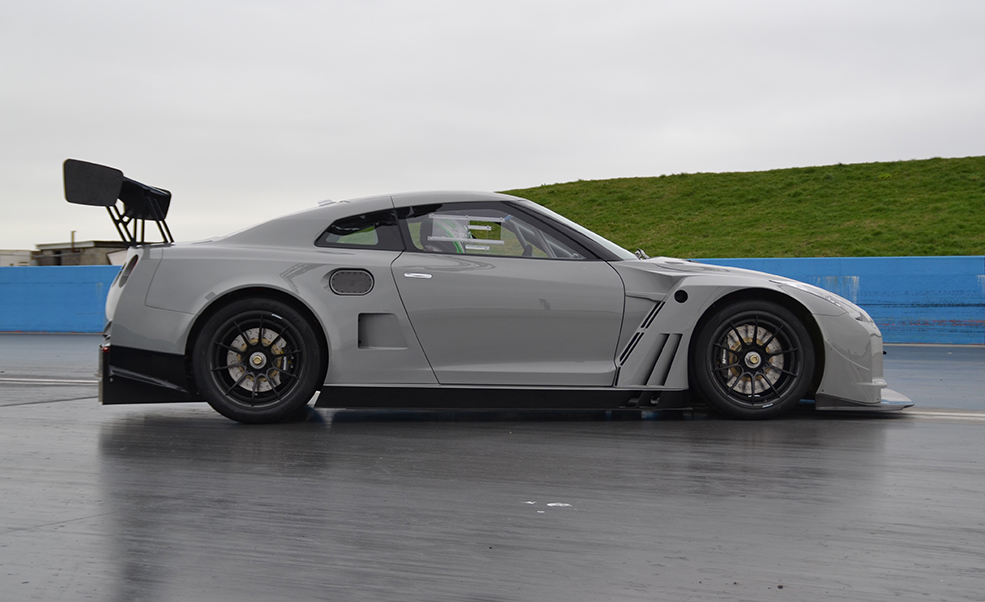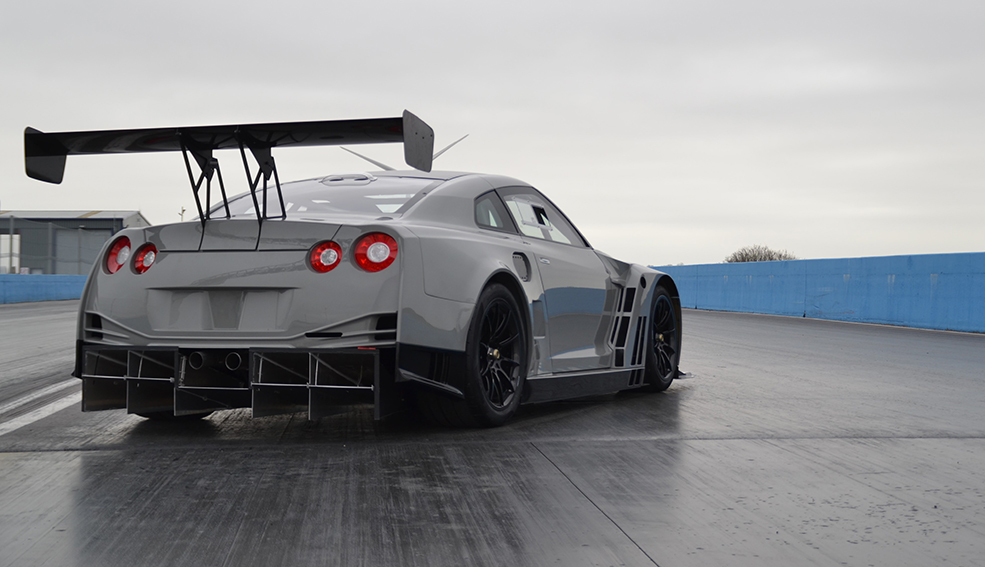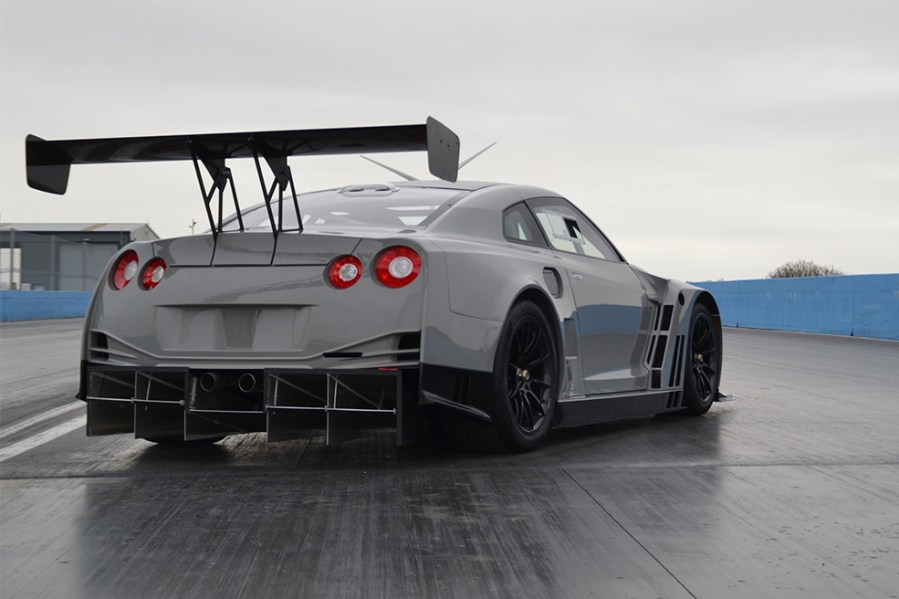Fancy a Nissan GT-R GT3 car for the road? Well JRM has you covered. Say hello to the 500bhp/tonne JRM GT23 supercar.
Limited to just 23 examples, the GT23 is powered by a race-ready version of the VR38DETT engine (3.8-litre V6 twin-turbo). Making use of a full carbon fibre body and floor enables the JRM GT23 to boast a 500bhp/tonne power-to-weight ratio. That engine, though, has been moved further towards the driver and lower down for a front mid-engine layout for a lower centre of gravity. Thankfully, changes to the fuel system and mapping means it will accept pump fuel.
The brief from the off was to deliver an unsurpassed driving experience that placed the driver at the epicentre of operations, with the aim of making it the most driver-centric car built for both the track and the road.
Want to know why it’s called the JRM GT23? Nissan often enter motorsport events with its cars numbered 23, which in Japanese, is pronounced “Ni” (2) and “San” (3). Couple that with the 10 year anniversary of JRM winning the World Championship in the Nissan GT-R Nismo GT1 back in 2011 and it was a no-brainer.
Elliot Dason-Barber, the project’s Technical Director, said: “The objectives of the project were always to road legalise a 2015MY GT-R GT3 race car. To make it friendly enough to be driven on the road but competent enough that you receive a genuine race car experience when you take it to the track. The GT-R GT3 did not have flaws, it only had limitations.”
The benefit JRM had with the GT23, unlike the original GT3 car, is that they were not restricted by race regulations, or even aesthetic constraints from a Company Styling team. As a result, moving the engine layout allowed the team to redesign the front to revise airflow into the car. These revisions include a cooling pack and a bonnet exit duct system to better manage airflow extraction to maximise cooling efficiency
A flat carbon floor now feeds a far more voluminous diffuser, which can be balanced by an appropriately sized adjustable rear wing.

Suspension and Steering
In harmony with the aerodynamics the JRM design team have re-engineered the front and rear suspension and the steering. By re-positioning the engine, it has given the team the opportunity to re-design the front suspension and sub frame so that now all of the structure that supports these components is tied together in the subframe constructed in a high-grade stainless steel. One of the limitations of the GT3 Race car is that it uses the geometry from the road car. The road car geometry is optimised at a certain height on the road so when attempts are made to lower it for a race car the suspension behaviour starts to operate outside of what it has been designed to do. Therefore, the tyre and steering behaviour of the race car never really reach its potential, according to JRM.
Special lightweight suspension links and GT23 specific uprights, supporting knock-on race hubs, have been designed for two unique variants of wheels. All have been designed with a focus on reducing unsprung mass. For the track, the 18-inch lightweight aluminium wheel option whilst for the road version DyMag 20-inch carbon wheels. A new damper design has also been developed with its partners R53, who produced a electronically adjustable ride height setup that can be adjusted via a button inside the cockpit to lift or lower the car by 40mm, depending on whether you’re on track or on the road.

Even the steering has been completely re-designed, providing a the GT23 unique geometry, ratio, and EPAS assistance levels to the GT23. A mechanical linear rack ensures more feedback through the steering wheel, which is linked to a fully adjustable (rake & plunge) and fully collapsible column, which in turn is supported by an electrically powered motor from DC Electronics.
All of the electronic systems are now fully integrated and connected on one seamless bespoke system. This means the engine, brakes, suspension, steering, and shift control, as well as the power distribution, and data logging, are all channelled through the one holistic system. As a result, JRM can accurately monitor all the systems ensuring each operates correctly. A comprehensive, but expandable race data logging is also standard fit to each vehicle. The same can be applied to the road car settings whilst additional sensors will be added measuring acceleration and body movement plus inertia and aerodynamic characteristics so JRM can look at the response of the car.
The team have also implemented a race ready solid-state power management system, as against the traditional fuse system, providing more control over the car, and giving far more reliability, according to JRM.

Cooling and Electronics
The GT23 has completely unique front cooling pack and is managed for air flow. Underneath the skin of the bonnet and front bumper, commonly known as the ‘bucket’ whereby the air will normally flow through the grill, pass through the cooling pack and dissipate through the engine generating a lot of vortices, creating drag which is not efficient on the cooling. The JRM re-design of the front cooling pack manages the air flow very carefully, ensuring the air comes in, ducted through the cooling systems and is guided progressively out and over the top of the engine and then sucked out of the ‘butterfly wings’ in a low-pressure area. This minimises the drag effect in this area and actually adding downforce to the front of the GT23. The benefit has a double affect, far more efficient cooling and better aerodynamics.
To assist all of this to happen Elliot and his team have had to re-design the whole cooling systems including the radiators, inter coolers, gearbox cooler, oil coolers, intakes for the engine, the brake and driver cooling ducts.
As a result of re-positioning the engine the design team have crafted an all-new oil system with a dry sump system all custom made and re-design of the cooling and intake systems, with all of the ancillaries being moved to the back of the car and onto the gearbox. Speaking of which, that gearbox is a Hewland 6-speed sequential paddle shift box on air shift system, which now sits at the rear of the car.

JRM GT23 performance
Each body panel of the GT23 has been designed utilising the lightest of materials, carbon fibre, as against the standard version in steel monocoque design whilst the stiffness of the chassis has been increased on the original by designing a bespoke FIA compliant safety cage which forms part of the chassis. The engine and suspension loads are passed through this structure by being connected to front and the rear of the cage which have huge increases from a torsional perspective above both road and race cars. The safety cage adds an additional 60Kg to the weight of the car, however, the target weight of the whole car is 500kg lighter than the standard road car with a target of weight of 1350kg.
The power plant has received attention from the engine division of JRM, with new design pistons and conrods, new specification camshafts and new turbos, so a substantial upgrade on the standard GT3 engine.. The standard engine is 550hp but the GT23 team are looking to achieve 500hp per tonne and not looking for a particularly high-power target but to achieve manoeuvrability and agility.
There will be an option for customers to up the power to 750hp as part of an Extreme Pack, which will allow the owner to develop the car, with the JRM Engineers, to the next level of racetrack preparation, including an increase of power, air jacks, fire system, race wheels and additional aero options.

On the braking side of things, unique six-pot calipers and 380mm steel discs from AP Racing sit at the front while four-pot 355mm steel brakes sit at the back. Crucially, each brake receives its own dedicated cooling duct.
Inside, the aim was to blend the race cockpit with soft touches, and thus the use of lightweight carbon materials and Alcantara have been used, while two Corbeau bucket seats with six-point harnesses are fully FIA compliant. Before each customer takes delivery, a seat fitting will take place at JRM to ensure the driving position is perfect for the driver.
All operations for the driver will go through the one dash panel, the Alcantara steering wheel and a centre switch control located on the centre tunnel, so the driver is focused on the driving experience with very little distractions. So, with the press of a button the driver can change the mode of the car from track performance information to road conditions. An easy to scroll through system that can be personalised to the drivers’ style of driving be it on track or the open road. The team also understand that owners may wish to go on a short overnight trip, so a small functional boot has been incorporated to hold an overnight bag.
There’s no word on pricing, but with examples limited to just 23, we can’t expect a race-ready GT-R GT3 car in the form of the JRM GT23 will be cheap… we want one anyway though!




